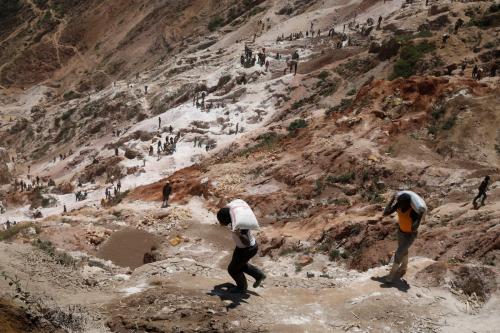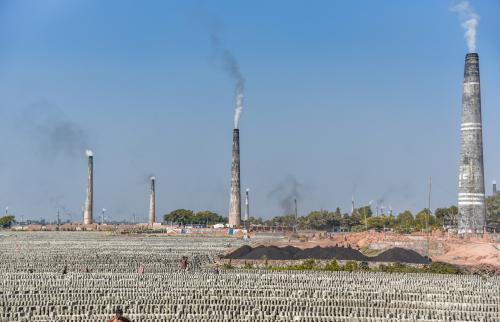Editor’s Note: This article was originally published by APMEN.
In October last year, the Norwegian and Swiss governments launched the Nansen Initiative on Disaster-Induced Cross-Border Displacement. It aims to build a consensus on key principles and elements regarding the protection of persons displaced across borders in the context of natural disasters that sets the agenda for future action at domestic, regional and international levels. It marks a tentative first step towards international policymaking in this field.
The direct genesis of the Nansen Initiative was a joint pledge that Norway and Switzerland made at UNHCR’s Ministerial meeting in December 2011 to commemorate the 60th anniversary of the Refugee Convention and the 50th anniversary of the Convention on the Reduction of Statelessness. Throughout 2011, UNHCR had spearheaded efforts to get States to agree to the formulation of a global guiding framework on displacement relating to climate change and natural disasters. It had hoped that most States would make pledges to that effect at the December 2011 meeting. However, only five States did (Norway, Switzerland, Costa Rica, Germany and Mexico).
It became very clear that States wanted to retain control over any developments in the protection space, and were prepared only to take tentative steps (if any at all). The Nansen Initiative, which will be operational from 2013 to 2015, is designed to promote a bottom-up approach to the issue.
First, a series of sub-regional consultations will be conducted to gather more information about the varying challenges faced – as well as good practices adopted – in different parts of the world. They will focus on the various phases of displacement: preparedness prior to displacement, protection and assistance during displacement, and solutions following displacement. The first consultation is to be held in the South Pacific in May this year. In identifying standards of treatment and good practices relating to cross-border displacement in the context of natural disasters, the meeting will also focus on issues of particular pertinence in the Pacific, such as customary land laws, the protection of cultural heritage and identity, and the impacts of increased urbanization.
Secondly, through a global dialogue, the Nansen Initiative hopes to develop a non-binding “Protection Agenda” based on three pillars: international cooperation and solidarity; standards for the treatment of affected people regarding admission, stay, status; and operational responses, including funding mechanisms and responsibilities of international humanitarian and development actors. It is envisaged that the Protection Agenda will serve as “a framework for further normative, institutional and operational development at different levels.”
While the Initiative’s approach may be criticized as too tentative, it seems to be the only feasible strategy at this point in time. As its Envoy, Professor Walter Kälin, explained at the first Consultative Committee meeting, an absence of sufficient knowledge about what happens on the ground would make it difficult at this stage to draft a set of guiding principles adequately reflecting realities, and there was of course the practical obstacle, namely “the difficulty of getting governments on board with the idea of producing a normative framework right away.”
Although the Nansen Initiative is State-led, there is a strong emphasis on its being an open, dynamic, and inclusive process that will actively involve non-State stakeholders. It is co-chaired by Norway and Switzerland and overseen by a Steering Group including Australia, Bangladesh, Costa Rica, Germany, Kenya, Mexico and the Philippines. The composition of the Steering Group aims to ensure adequate and balanced representation from the Global North and South. A Consultative Committee comprised of representatives from relevant international organizations, NGOs, think tanks and academics informs and supports the process. The Envoy of the Chairmanship represents the Initiative and provide strategic advice, while a small Secretariat in Geneva provides logistical support.
The Nansen Initiative’s substantive focus is on disaster-induced cross-border displacement. It adopts the definition of disaster used by the UN’s humanitarian community: A serious disruption of the functioning of a community or a society involving widespread human, material, economic or environmental losses and impacts, which exceeds the ability of the affected community or society to cope using its own resources. Importantly, rather than conceptualizing a disaster as an event, the emphasis is instead on its consequences – the coping capacity of those affected. This is particularly important given the Initiative’s focus on both sudden-onset disasters (defined as hydro-meteorological hazards such as flooding, windstorms or mudslides, and geophysical hazards including earthquakes, tsunamis or volcano eruptions) and slow-onset disasters (defined as environmental degradation processes such as droughts and desertification, increased salinization, rising sea levels or thawing of permafrost). While the concept of a slow-onset disaster seems counterintuitive if one thinks of a disaster as an event that happens (like a flood or landslide), it makes sense when a disaster denotes diminished coping capacity.
However, slow-onset disasters only come within the ambit of the Initiative in their end phase (i.e. when droughts or rising sea levels create life-threatening situations), since this is when their effects may be very similar to those of sudden-onset disasters. The Initiative emphasizes that the relevant distinction should not be the character of the disaster but rather whether it triggers displacement understood as forced movement of persons as opposed to voluntary migration. In my view, this sits uncomfortably with scenarios where migration is a rational and desirable form of adaptation, such as in some small island States. Arguably, the greatest challenge lies in responding to the impacts of slower processes which pose risks to the sustainability of certain human settlements over the longer term. Without any sustained examination of what it means for migration to be a form of adaptation, it is inevitable that protection gaps will remain. It is crucial that the existence of the Initiative is not used as an excuse to delay policy development in these areas.
Of course, it remains to be seen precisely how States involved in the Initiative will conceptualize displacement and disasters, especially once the sub-regional consultations have highlighted the challenges faced in specific contexts (including in small island States). Could the idea of a creeping disaster be one way of incorporating anticipatory movement as a protection response? As the Initiative has already acknowledged, the legal challenge will be to identify the tipping point where the basically voluntary movement of persons turns into forced movement. Since, operationally, there may be considerable overlap between the two, it will be necessary to ensure that people displaced as a result of slow-onset disasters also receive protection and assistance.



Commentary
Op-edCreating New Norms? The Nansen Initiative on Disaster-Induced Cross-Border Displacement
April 1, 2013